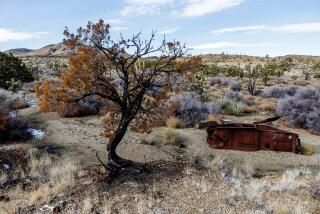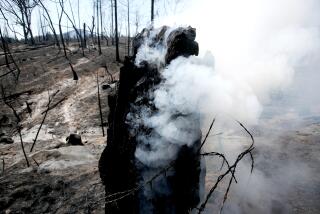Anasazi Sites Surrendering Their Secrets
CIMARRON, N.M. — Delayed by a threatening forest fire and a daily climb up a sheer cliff, archeologists excavated and cataloged a seasonal rock dwelling they say may have been used 1,500 years ago by an ancient Indian family.
Warren Lail, a 51-year-old attorney-turned-archeologist, has headed University of Oklahoma excavations at the Philmont Scout Ranch for two successive summers. He’s focusing on a little-known area occupied by eastern Anasazi, believed to be ancestors of several Indian tribes.
Last year’s site on Middle Ponil Creek has been radiocarbon-dated at AD 780. The nearby site excavated this summer on North Ponil Creek, Lail said, is about 200 feet higher and may be 200 years older -- atop a high rock ridge that requires mountain-climbing gear to reach. By late July, the team had gathered more than 800 artifacts, such as arrow points.
But the four-member group came close to losing everything. When lightning started several fires on the Scout ranch in late May, the team was asked to stay clear of its excavation. The Ponil Complex fire burned 92,500 acres.
When the team did return 22 days later, they found charred brush less than 100 feet from the excavation, with its crisscrossing of yellow string and laser-leveled camera.
The archeologists plan to use a digital camera next year to photograph each square meter of the dig each day.
Lightning, a perennial hazard at a ranch overseeing 20,000 Scouts each summer, drives the research team off the canyon rim nine days out of 10, says graduate student Brian Lizzo of Chicago. The team usually pulls out by 3 p.m., when the rumblings start. The digs generally begin every day by 5:30 a.m.
“We’ve been rushed off the mountain a few times,” Lail said.
Last summer, Lail had said that if carbon-dating showed the sites studied in 2001 and 2002 were used concurrently, that could indicate they had been used by the same family migrating from site to site as seasons changed.
This summer’s site is believed to have been used during the fall for hunting and gathering nuts. It is believed to have been used far more frequently than the 2001 site had been. But the fact that it also seems to be 200 or more years older, from AD 500-700, may preclude the same family’s having used it. Carbon-dating will help determine its precise age.
Both sites are nearly 200 miles east of Anasazi ruins at Chaco Canyon and Mesa Verde.
An oddity for their estimated time frame, though, is the lack of pottery fragments, Lail said. Pottery normally would have been part of their culture by AD 700. But these hunter-gatherers were not that far along culturally, he said.
“They’re a little bit behind,” he said. “Ideas may have been slow to travel.”
A day earlier, Lail found an arrowhead that he estimated could date as early as AD 400. It was perfectly formed with subtle flaking, and he said it seemed never to have been used.
Although fire delayed their work this summer, he said, it may make future summers easier. Fire has a way of burning off the cover that hides archeological sites and subsequent rains wash artifacts out into the drainages and riverbeds.
“We think that’s going to be the case up here,” he said.
Some arrow points have already washed down from the burned area across North Ponil Canyon.
“My intention is to survey the entire area now that it’s burned,” he said.
More to Read
Sign up for Essential California
The most important California stories and recommendations in your inbox every morning.
You may occasionally receive promotional content from the Los Angeles Times.










